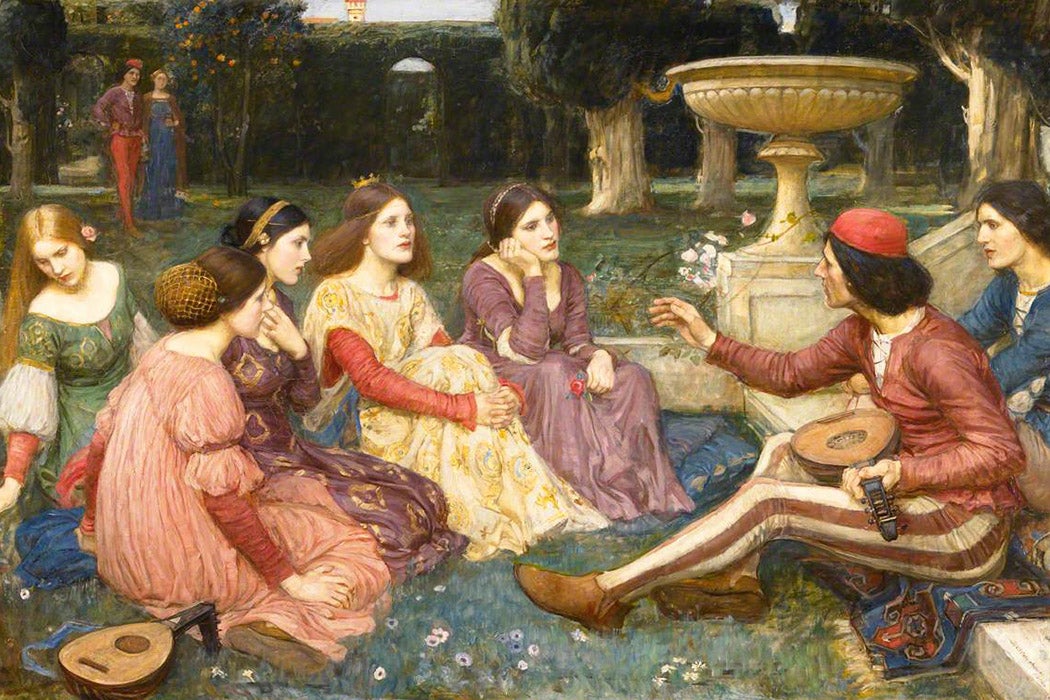Ten young Florentines take shelter in an isolated villa to escape the plague. To keep body and soul together, they tell love stories. This is the premise of Giovanni Boccaccio’s Decameron (1353): ten nights, one hundred stories of erotic, tragic, and farcical amore—all to while away the long hours of quarantine during the outbreak of plague in Europe, which began in 1347 and lasted several years. Over six centuries later, the book is Amazon’s number-one best-selling work of Italian literature.
In addition to giving the world a significant and highly influential literary work, Boccaccio (1313-1375) also served up some medicine. Italian studies scholar Martin Marafioti explores how the wildly popular book influenced medical treatises after the early 1350s.
As Marafioti explains, the Decameron spread widely and to great acclaim among the middle class in the latter part of the Trecento—that is, the fourteenth century in Italian culture. That means that “just as Boccaccio was inspired by contemporary medical theories for his frame story, it is also likely that Boccaccio influenced his contemporary society, in particular the medical community.”
Fourteenth-century medical treatises of the time of the initial outbreak of the Black Death in Europe had “physicians propose that happiness lifts people’s spirits and strengthens their mind and body so that they will not succumb to contagion.” “Laughter is the best medicine” is an old tradition.
After 1351, what Marafioti calls “narrative prophylaxis”—reading, storytelling, and singing, the obvious lessons of the Decameron—were added to the doctors’ regimes for fighting disease and, especially, the emotional horror of mass death suffered by survivors. While a direct relationship between Boccaccio’s success and the new literary cure is impossible to pin down, the fact remains that after the Decameron began circulating, doctors started to “specifically advocate literary pursuits as a way of diverting the mind and maintaining spirits high.”
Boccaccio’s work was not much appreciated by the “cultural and intellectual elite” of Florence. For one thing, it was written in the vernacular Tuscan and elites still used Latin. But the book was wildly popular among the middling classes, the “merchants, bankers, shop owners, and workers.” Few of them knew Latin. Most Tuscans could not read at all, actually, but they could certainly be read to.
And what they heard or read themselves was essentially the first Italian literary work to tackle the pestilenza. But it wasn’t about the pest: it was about the foibles of love and lust. It was a brilliant diversion from the onslaught of pandemic disease.
“For centuries, doctors continued to prescribe emotional balance as key to overall health, especially in times of epidemic outbreaks [and] numerous healers have specifically advocated a form of narrative or literary prevention.”
Weekly Newsletter
Medicine has obviously changed a lot over the centuries. We now know, for instance, a lot more about microbiology, disease vectors, and our immune systems. The best “medicine” for fighting the new coronavirus, however, remains physical distance and old-fashioned hygiene. Your mother was so right when she told you to wash your hands.
But mental health also remains vital. Keeping one’s spirts up—admittedly hard to quantify scientifically—has never gone out of style. A good book, a good story, is diverting and morale-building. Story-telling—the shared narrative—is even better. That made Boccaccio the talk of the town almost seven centuries ago. It’s still a good plan.
Support JSTOR Daily! Join our new membership program on Patreon today.







